Prevent, rather than treat, diseases for optimal success

Shrimp health management is generally a holistic activity in which the focus is on disease prevention through good nutrition, sound pond management and stress reduction rather than disease treatment. Shrimp health is strongly influenced by environmental conditions in the culture environment and physical, chemical, and biological factors that contribute to the growth, health and production of farmed shrimp.
Environment and shrimp health
Shrimp health management is a function of maintaining good water and bottom soil quality through good management techniques. These include minimizing water quality fluctuations to reduce stress in shrimp, maintaining stable populations of microalgae, and keeping concentrations of harmful substances low enough to not adversely affect shrimp behavior and physiology.
Water should only be exchanged when necessary, and always drained from the bottom of the pond to help flush sediments accumulated near outlets. Overfeeding and the accumulation of organic matter and attendant anaerobic conditions on pond bottoms must be managed to preclude the exchange of nutrients between bottom soil and the overlying water.
Start with PLs
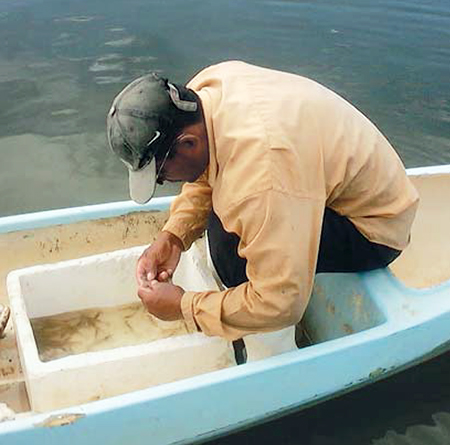
One hundred animals from all incoming postlarvae (PL) shipments from each supplier should be examined clinically and evaluated before stocking. Additionally, two samples of PL should be saved, one in Davidson’s solution for histology (transferred to 50 percent ETOH after 24 hours) and one in 95 percent alcohol for polymerase chain reaction testing. These will be examined only if a problem develops during grow-out.
Clinical examination of 20 shrimp per pond from approximately 10 percent of the ponds should be done on a weekly basis. The shrimp should be randomly caught from at least two different sites in each pond. These shrimp can be the same ones used to determine the weekly pond biomass, but must be examined while they are alive.
Pond observations
- During shrimp sampling, it is wise to look for the following:
- Plankton blooms, color of water, shrimp swimming on the surface or shoreline.
- Dead shrimp in the pond, stressed or dead shrimp on feed trays.
- Shrimp with empty guts, excess feed on trays.
- Shrimp with soft shells or heads, fouling on shell.
- Flaccid shrimp, shrimp with deformities.
- Red discoloration of shrimp append-ages or uropods.
- Dense white appearance or opaque muscles in shrimp.
- Brown or black gills or fouling in shrimp gills.
- Shrimp with wounds, black areas, or spots.
- Shrimp with missing or black appendages.
- Shrimp with black shells and superficial infections, chronic localized bacteria infections (black lesions or splinters).
- Shrimp with bent or cramped tails, white muscles, or muscle degeneration.
- Shrimp color and relative size of hepatopancreas.
- Pond bottom conditions, presence of organics or other sources of contamination.
Examinations
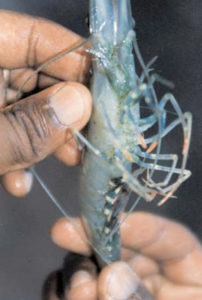
Specific individuals should do clinical examinations in order to have consistent data. The exams determine the percentage of shrimp in the sample that are “clinically sick.” Sick shrimp have one or more of the following: lethargy, anorexia (empty intestinal tract), soft shells, fouled gills, or black areas on the shell. Additional clinical signs can be added to meet the needs of a particular farm.
A general statement of the overall health of the pond should also be recorded. This would include a subjective evaluation by the pond manager that includes feed consumption as indicated by the use of feeding trays, bird activity, and the number of dead shrimp seen. If the farm has a survival problem and it is not known when the animals are dying, examinations of the pond bottoms at weekly intervals may be necessary. Details of sampling should always be recorded (dates, times, locations, pond conditions, etc.).
Histology
When shrimp are approximately 5 grams, samples from 5 to 10 percent of the ponds should be examined histologically. This should represent a random sample caught with a cast net from two different pond locations, and include 10 shrimp per pond. Sampling should then be done on a monthly or bimonthly schedule. Sampled shrimp should be injected in multiple areas and fixed with Davidson’s solution for 24 hours, then transferred to 50 percent percent alcohol.
Examinations should also be performed at harvest on all ponds. Shrimp that demonstrate any signs of clinical disease or abnormalities should be prepared for histological examination.
If dead or sick animals are observed during sampling, remove 10-20 each of the suspect and healthy animals and send them to the lab. Animals under 1g should be sampled as a group. Large animals should be examined individually. Sampled animals should be placed on ice and preserved as soon as possible after being removed from the pond.
Major stressors
The main environmental and husbandry stressors that disturb the normal physiological balance of shrimp and render the animal more vulnerable to disease include:
- Unionized ammonia and nitrate in the presence of high pH.
- Insufficient oxygen and elevated carbon dioxide levels.
- Extreme or rapid changes in salinity, temperature, pH, alkalinity.
- Molting, excess handling, or high density of animals.
- Poor nutrition.
- Presence of heavy metals, pesticides and bacterial or algal toxins.
- Parasitism.
- Obligate pathogens that produce disease in healthy hosts, and opportunistic pathogens that produce disease in weakened hosts.
Detecting pathogens, diseases
For shrimp farmers, the most important aspect of disease diagnosis is the ability to detect the pathogen at the earliest stage and minimize losses by treating the disease or reducing the stressors. Once the disease has been confirmed, attempts to bring it under control can begin and the efficacy of any treatment can be evaluated.
The diagnostic process involves detecting the agent responsible for the disease and its contribution to the disease incidence. Farm staff need to be trained to recognize the gross clinical signs of the disease by observing shrimp in the ponds and by microscope. Rapid diagnostic tools like staining, hemolymph smears, squashes, bacterial cultures, and gill and hepatopancreas exams can be used to monitor health and make diagnoses. Inexpensive rapid diagnostic kits are also available for the detection of some viruses.
Farms should use outside laboratories to do molecular assays like dot blots, in situ hybridization and polymerase chain reaction to confirm diseases. The laboratories should also be capable of histological and microbiology work.
Animal health management
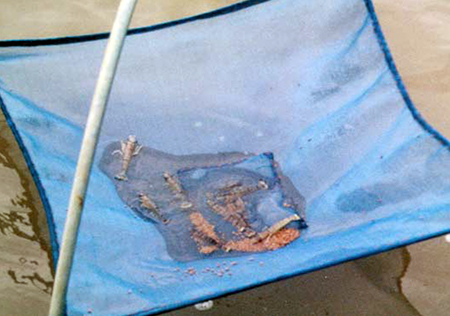
The Global Aquaculture Alliance Codes of Practice for Responsible Shrimp Farming include three basic premises for shrimp health management:
- Many disease problems can be prevented through stress management.
- Disease treatments should be made only after a clear diagnosis of causative factors.
- Spread of disease should be minimized by reasonable regulation of importations of broodstock and larvae and by isolation and disinfection of affected ponds.
Management practices
Suggested practices for managing animal health, stress, and diseases include:
- Evaluate and stock only healthy, disease-free postlarvae from reputable hatcheries.
- Provide proper acclimation and transportation of stocked animals. Avoid unnecessary handling.
- Use proper stocking densities for the culture systems used. Do not mix species in the same pond.
- Filter the water supply to a minimum of 250 μ.
- Use good-quality feed and feed management to promote efficiency and eliminate overfeeding.
- Maintain good water quality and pond bottoms.
- Use only safe and approved antibiotics, chemicals, and drugs at recommended concentrations, and adjust treatments to comply with national and international regulations.
- Monitor shrimp routinely for stress, disease and health problems.
- For mild infectious diseases with the potential to spread, quarantine the pond and carry out the best option for disease treatment. Eliminate water exchange and discharges.
- For serious diseases that spread quickly, like White Spot Syndrome Virus and Yellow Head Virus, net harvest the remaining shrimp, disinfect the pond without discharging any water, prevent the escape of animals into the environment and notify neighboring farms of the problem.
- Treatable diseases like Necrotizing Hepatopancreatitis should be addressed as early as possible with approved antibiotics at recommended doses.
- If possible, ponds should be cleaned and disinfected between crops. Periodic dryouts of several weeks are recommended to manage the buildup of organic material. Ponds can be disinfected with 1 to 2 tons per hectare of burnt lime (calcium oxide).
- Monitor the environment, especially water supplies, for pesticides and other contaminants at least twice a year.
- Each farm should strive to set up a biosecurity program that addresses its particular needs.
- Any dead shrimp from ponds should be disposed of in a sanitary manner, such as treating with quick lime followed by burial at 60 to 90 cm deep.
- Effluents, sediments, material from dredging and other wastes should be disposed of in a safe, responsible manner that will not affect other farms in the area.
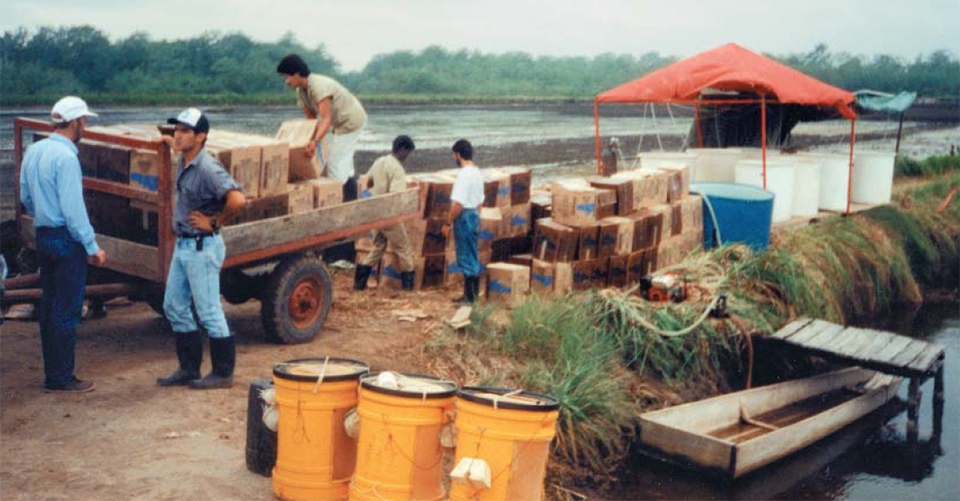
Disease management
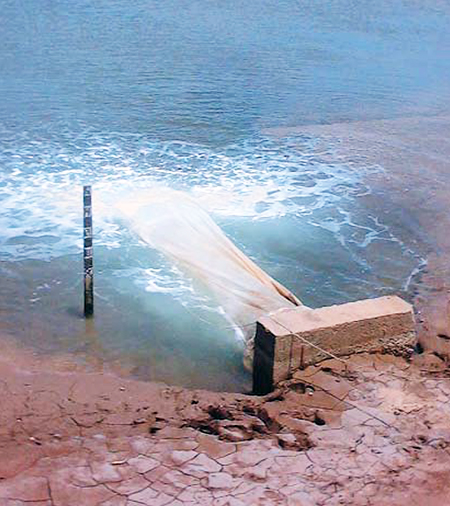
Fegan and Clifford (2001) categorized farm management strategies when confronted with diseases.
Stocking strategies
Instead of PLs, stock juveniles grown in raceways or other biosecure environment. This provides an opportunity to stock larger, more tolerant shrimp while at the same time reducing the duration of the cycle.
Stocking densities
Stocking densities must take into consideration the prevailing disease conditions and risks to production success. What is appropriate for one disease may not be appropriate for another.
Water exchange
Water exchange involves high risk for disease outbreaks when viral diseases are present. If disease probability is high, the practice of zero water exchange for the first 60 days is recommended, and open flow through pond systems is discouraged.
Feed management
Good feed management is important to maintain good water quality. Uneaten feed causes deterioration in pond bottoms that results in higher oxygen demand and animal stress. Feeding on trays is recommended if labor resources and conditions make it feasible.
Increase host defenses
Although shrimp are not believed to have an immune system, various additives – including immunostimulants, vitamin supplements, trace minerals, highly unsaturated fatty acids, and carotenoids – can be incorporated into diets to increase the shrimp immune defenses. The most commonly used immune stimulants include beta-glucans and peptidoglycans.
Pond management
- Alternative management strategies could include:
- Periodic dry-outs and seasonal cropping when seasonal differences in shrimp performance exist. Production should be maximized during the good season.
- Low-density culture in the season when disease risk is highest and higher densities when conditions are more favorable. Consider compensatory stocking if mortalities occur at stocking or stocking of juveniles when PL mortality is high during certain seasons.
- Supplemental aeration with no or limited water exchange.
- “Crop holidays” to allow disease to die off through a lack of hosts. This strategy would require compliance by all farmers in the area, and that risks be defined and isolated.
- “All-in/all-out” production to prevent transfer of diseases by different stocks of different ages. This is practically important to small farms, intensive farms, and hatcheries.
Conclusion
Preventive health programs at aquaculture facilities include the establishment of a population of healthy, disease-free animals. Good monitoring and record-keeping systems should be established. Close surveillance for diseases can provide advance warning of potential problems. Programs can then be established to promote animal health and fight diseases.
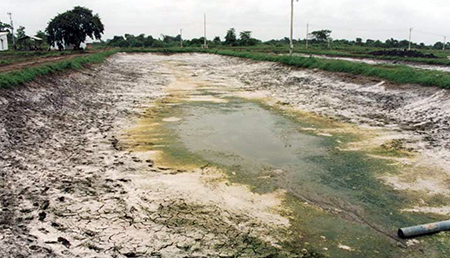
Farm and project managers must understand that no single management technique can successfully protect a farm from disease problems. Rather, the combined benefits of numerous efforts must be unified into an integrated plan. The most successful strategies for controlling virus diseases in ponds have been based on a combination of exclusion of pathogens and vectors, and management practices that focus on creating a healthy, nonstressful environment for the shrimp.
(Editor’s Note: This article was originally published in the October 2002 print edition of the Global Aquaculture Advocate.)
Now that you've finished reading the article ...
… we hope you’ll consider supporting our mission to document the evolution of the global aquaculture industry and share our vast network of contributors’ expansive knowledge every week.
By becoming a Global Seafood Alliance member, you’re ensuring that all of the pre-competitive work we do through member benefits, resources and events can continue. Individual membership costs just $50 a year. GSA individual and corporate members receive complimentary access to a series of GOAL virtual events beginning in April. Join now.
Not a GSA member? Join us.
Authors
-
William R. More
More & More Consulting Services, Inc.
PMB 647
15600 N.E. 8th, Suite B-1
Bellevue, Washington 98008 USA -
Paul Frelier, Ph.D.
Mariscos Veterinary Services, Inc.
Heyburn, Idaho
Tagged With
Related Posts

Health & Welfare
‘Big picture’ connects shrimp disease, inbreeding
Disease problems on shrimp farms may be partly driven by an interaction between management practices that cause inbreeding in small hatcheries and the amplification by inbreeding of susceptibility to disease and environmental stresses.

Responsibility
Bacterial amendments in shrimp grow-out ponds
Pond microbial communities are a critical and often overlooked component of aquaculture ecosystems. Bacterial amendments like probiotics provide significant support to shrimp farmers around the world.

Health & Welfare
AHPN inferences based on behavior of vibrio bacteria
Vibrio parahaemolyticus, a strain of which is the cause of acute hepatopancreatic necrosis (AHPN), has both virulent and benign strains. This strain colonizes the stomachs of shrimp by the formation of a biofilm, which protects it from antibiotics and other potential treatments.

Health & Welfare
Determining causes of osmotic stress in Pacific white shrimp postlarvae
This study evaluated the relationship between the molting stage, age and osmotic stress in Pacific white shrimp postlarvae. The results indicate that osmotic stress tests should be done only with at least PL12 at the intermolt stage and that were cultured at 35 ppt salinity and 29 degrees-C.


